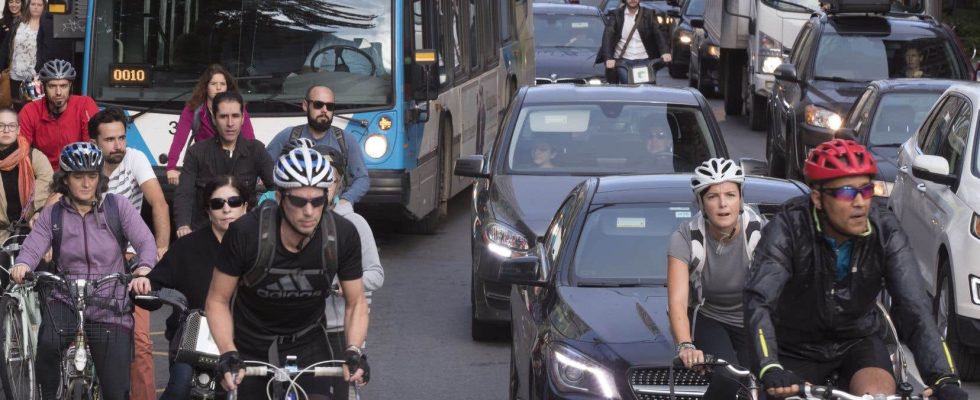Motorists who brush against cyclists or who open their doors without watching for the presence of bicycles on the roadway are not sanctioned by the Montreal police. This type of offense has been relatively stable in recent years, or even declining in some cases, according to statistics made public by the Act respecting access to documents held by public bodies.
On average, 20 tickets per year have been issued by the Service de police de la Ville de Montréal (SPVM) to drivers who have overtaken cyclists too closely or too quickly since 2017. As for the tickets for the risk of door entry – opening a car door that can block the passage of a bicycle – they are down slightly, from 61 to 38 for the period from 2013 to 2022. For the same years, the total of offenses committed by motorists that could endanger cyclists and which also include, for example, not respecting a stop line or using a cell phone while driving fell from 92,091 to 46,899.
As for the number of offenses committed by cyclists – such as the absence of reflectors or lights on a bicycle, the non-respect of red lights or signals, traffic on sidewalks, the wearing of headphones or the use of cell phones –, it has practically been halved in Montreal since 2018.
“An increase or decrease in offenses can be as much related to an actual variation in behavior related to the offense as a variation in the presence and zeal of police officers,” explains Nicolas Saulnier, full professor in the Department of Civil, Geological and Mining Engineering at Polytechnique Montréal.
According to him, it is “unlikely” that all these types of offenses – both on the part of cyclists and motorists – will decrease in this way, at the same time. An opinion shared by Mario Grenier, an experienced cyclist from the Montreal region. It was he who obtained the SPVM statistics on violations of the Highway Safety Code over the past decade. “It would be surprising if the significant drop was solely attributable to a significant increase in respect [du Code de la sécurité routière] he says.
At the time these lines were written, the SPVM had not been able to answer the questions of the Duty.
The “tip of the iceberg”
Specifically, the decline was observed in almost all offenses committed by cyclists or motorists. There is one exception, however: the fines issued to motorists parking on a cycle path have risen sharply, from 98 to 314 since 2013.
The fact that [les chiffres] are so weak, it is problematic. This is really just the tip of the iceberg.
Louis Lalonde, project manager at Vélo Québec, believes that the number of reports issued by the SPVM is not representative of the daily reality experienced by cyclists. ” The fact that [les chiffres] are so weak, it is problematic. This is really just the tip of the iceberg,” he worries.
However, as early as 2019, police officers on bicycles began to use a device allowing them to measure the distance from cars when they are overtaken by them. A measure that has obviously not borne fruit, given the low number of offenses reported since, according to Louis Lalonde.
“Getting brushed against on a bike when there’s no completely separate bike lane happens a lot,” he says. “There is special attention that should be given to this type of offence, and the reason is very simple: these are situations that can lead to serious injury and death. »
A need for cyclist safety
Regarding cyclists riding on the sidewalks, although the statistics have been falling for ten years, they are still relatively high (around 400 on average for the last three years, compared to 1456 in 2013).
On this subject, the Highway Safety Code specifies that “the cyclist cannot ride on a sidewalk, except in case of necessity or unless the signage prescribes or allows it”.
These cases of necessity are, for example, when a moving truck, a broken down car, work or a narrowing of the lane force the cyclist to leave the roadway, explains Gino Desrosiers, spokesperson for the Société de l’assurance automobile du Québec (SAAQ). For situations where the street is simply narrow, on the other hand, the decision rests with the policeman, he specifies.
“There is an arbitrary question in the application of this measure,” laments Louis Lalonde, of Vélo Québec. “Often, on a bicycle, riding on the sidewalks, it’s not an act of rebellion, it’s a search for security”, he underlines. “What we see in the scientific literature is that often, when you have a lot of people riding on the sidewalk and you put in a cycle layout, it drops drastically, because people are more comfortable. »
Solutions ?
To avoid finding themselves in a dangerous situation, “cyclists have the right to travel far enough from parked cars,” said the SAAQ spokesperson. “And if, as a motorist, we are not able to pass it safely […], you have to stay behind the cyclist. »
Additional efforts should also be made to better protect cyclists, according to Louis Lalonde: “The deployment of police forces is part of the arsenal of measures to ensure better coexistence and better safety on the road, but it is not the only front. This is done with the development of good infrastructure, and awareness campaigns. »
More generally, “this type of conflict between vehicles, automobiles, bicycles, scooters, it will be more and more common,” says Paula Negron-Poblete, professor at the School of urban planning and landscape architecture of the University of Montreal. “There are more and more fashions [de transport], but the street has not changed. And it was not designed for that. We will have to have a reflection on the sharing of this space. »
With Jean-Louis Bordeleau
